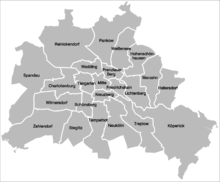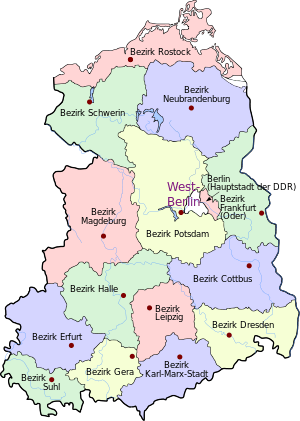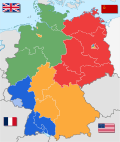East Berlin
| East Berlin Ost-Berlin Восточный Берлин Berlin (Ost) | ||||||
| Capital of East Germany (unrecognised as such by the Western Bloc); Soviet-occupied sector of Berlin (recognised as such by the Western Bloc). | ||||||
| ||||||
| ||||||
.png) East Berlin is shown in red. | ||||||
| Governing Mayor | ||||||
| • | 1948–1967 (first) | Friedrich Ebert, Jr. (SED) | ||||
| • | 1991 (last) | Thomas Krüger (SDP) | ||||
| Historical era | Cold War | |||||
| • | Established | 1949 | ||||
| • | Reunification | 3 October 1990 | ||||
| Area | ||||||
| • | 1989 | 409 km2 (158 sq mi) | ||||
| Population | ||||||
| • | 1989 | 1,279,212 | ||||
| Density | 3,127.7 /km2 (8,100.6 /sq mi) | |||||
| Today part of | ||||||
Part of a series on the |
|---|
| History of Berlin |
 |
| Margraviate of Brandenburg (1157–1806) |
| Kingdom of Prussia (1701–1918) |
| German Empire (1871–1918) |
| Weimar Republic (1919–1933) |
| Nazi Germany (1933–1945) |
| West Germany and East Germany (1945–1990) |
|
| Federal Republic of Germany (1990–present) |
| See also |
East Berlin existed from 1949 to 1990 and consisted of the Soviet sector of Berlin established in 1945. The American, British, and French sectors became West Berlin, strongly associated with West Germany, while East Berlin was the de facto capital of East Germany. From 13 August 1961 until 9 November 1989, East Berlin was separated from West Berlin by the Berlin Wall.
In East German official usage, it became widespread in the 1970s to refer to the Western part of the city as "Westberlin", whilst calling the Eastern part simply "Berlin". Officially it was referred to as "Berlin, Hauptstadt der DDR" ("Berlin, Capital of the GDR") (see also Naming conventions).
Overview
With the London Protocol of 1944, the United States, the United Kingdom and the Soviet Union decided to divide Germany into three occupation zones and to establish a special area of Berlin, which was occupied by the three Allied Forces together.[1] In May 1945, the Soviet Union installed a city government for the whole city that was called "Magistrate of Greater Berlin", which existed until 1947. After the war, the Allied Forces initially administered the city together within the Allied Kommandatura, which served as the governing body of the city. However, in 1948 the Soviet representative left the Kommandatura and the common administration broke apart during the following months. In the Soviet sector, a separate city government was established, which continued to call itself "Magistrate of Greater Berlin".
When the German Democratic Republic was established in 1949, it immediately claimed East Berlin as its capital - a claim that was recognised by all Communist countries. Nevertheless, its representatives to the People's Chamber were not directly elected and did not have full voting rights until 1981.[2]
In June 1948, all railways and roads leading to West Berlin were blocked, and East Berliners were not allowed to emigrate. Nevertheless, more than 1,000 East Germans were escaping to West Berlin each day by 1960, caused by the strains on the East German economy from war reparations owed to the Soviet Union, massive destruction of industry, and lack of assistance from the Marshall Plan. In August 1961, the East German Government tried to stop the population exodus by building the Berlin Wall. It was very dangerous for fleeing residents to cross because armed soldiers were trained to shoot illegal migrants.[3]
East Germany was a socialist republic, but there was not complete economic equality. Privileges such as prestigious apartments and good schooling were given to members of the ruling party and their family. Eventually, Christian churches were allowed to operate without restraint after years of harassment by authorities. In the 1970s, wages of East Berliners rose and working hours fell.[4]
The Western Allies (the US, UK, and France) never formally acknowledged the authority of the East German government to govern East Berlin; the official Allied protocol recognised only the authority of the Soviet Union in East Berlin in accordance with the occupation status of Berlin as a whole. The United States Command Berlin, for example, published detailed instructions for U.S. military and civilian personnel wishing to visit East Berlin.[5] In fact, the three Western commandants regularly protested against the presence of the East German National People's Army (NVA) in East Berlin, particularly on the occasion of military parades. Nevertheless, the three Western Allies eventually established embassies in East Berlin in the 1970s, although they never recognised it as the capital of East Germany. Treaties instead used terms such as "seat of government."[6]
On 3 October 1990, East and West Germany and East and West Berlin were reunited, thus formally ending the existence of East Berlin.
East Berlin today
Since reunification, the German government has spent vast amounts of money on reintegrating the two halves of the city and bringing services and infrastructure in the former East Berlin up to the standard established in West Berlin.
After reunification, the East German economy suffered significantly. Many East German factories were shut down due to inability to comply with West German pollution and safety standards, as well as inability to compete with West German factories. Because of this, a massive amount of West German economic aid was poured into East Germany to revitalize it. This stimulus was part-funded through a 7.5% tax on income, which led to a great deal of resentment toward the East Germans.[7]
Despite the large sums of economic aid poured into East Berlin, there still remain obvious differences between the former East and West Berlin. East Berlin has a distinct visual style; this is partly due to the greater survival of prewar façades and streetscapes, with some even still showing signs of wartime damage. The unique look of Stalinist architecture that was used in East Berlin (along with the rest of the former GDR) also contrasts markedly with the urban development styles employed in the former West Berlin. Additionally, the former East Berlin (along with the rest of the former GDR) retains a small number of its GDR-era street and place names commemorating German socialist heroes, such as Karl-Marx-Allee, Rosa-Luxemburg-Platz, and Karl-Liebknecht-Straße. Many such names, however, were deemed inappropriate (for various reasons) and changed after a long process of review.
Another popular symbolic icon of the former East Berlin (and of East Germany as a whole) is the "Ampelmännchen" (tr. "little traffic light men"), a stylized version of a fedora-wearing man crossing the street, which is found on traffic lights at many pedestrian crosswalks throughout the former East. These days they are also visible in parts of the former West Berlin. Following a civic debate about whether the Ampelmännchen should be abolished or disseminated more widely (due to concerns of consistency), several crosswalks in some parts of the former West Berlin also employ the Ampelmännchen.
Even to this day, 25 years after the two cities were reunified, the people of East and West Berlin have noticeable differences between each other, which become more apparent among the older generations. The two groups also have sometimes-derogatory slang terms to refer to each other. A former East Berliner (or East German) is known as an "Ossi" (from the German word for east, Ost), and a former West Berliner (or West German) is known as a "Wessi" (from the German word for west, West). Both sides also engage in stereotyping the other. A stereotypical Ossi has little ambition or poor work ethic and is chronically bitter, while a stereotypical Wessi is arrogant, selfish, impatient, and pushy.[8]
Soviet and East German Commandants of East Berlin
| Name[9] | Term |
|---|---|
| Nikolay Berzarin | 2 May 1945 – 16 June 1945 |
| Aleksandr Gorbatov | 17 June 1945 – 19 November 1945 |
| Dimitry Smirnov | 19 November 1945 – 1 April 1946 |
| Aleksandr Kotikov | 1 April 1946 – 7 June 1950 |
| Sergey Dienghin | 7 June 1950 – April 1953 |
| Pavel Dibrov | April 1953 – 23 June 1956 |
| Andrey Chamov | 28 June 1956 – 26 February 1958 |
| Nikolay Zakharov | 26 February 1958 – 9 May 1961 |
| Andrey Soloviev | 9 May 1961 – 22 August 1962 |
| Helmut Poppe | 22 August 1962 – 31 May 1971 |
| Artur Kunath | 1 June 1971 – 31 August 1978 |
| Karl-Heinz Drews | 1 September 1978 – 31 December 1988 |
| Wolfgang Dombrowski | 1 January 1989 – 30 September 1990 |
| Detlef Wendorf | 1 October 1990 – 2 October 1990 |
Boroughs of East Berlin

At the time of German reunification, East Berlin comprised the boroughs of
- Friedrichshain
- Hellersdorf (since 1986)
- Hohenschönhausen (since 1985)
- Köpenick
- Lichtenberg
- Marzahn (since 1979)
- Mitte
- Pankow
- Prenzlauer Berg
- Treptow
- Weißensee
Images of East Berlin
 Marx-Engels-Platz and the Palast der Republik in East Berlin in the summer of 1989. The Fernsehturm (TV Tower) is visible in the background
Marx-Engels-Platz and the Palast der Republik in East Berlin in the summer of 1989. The Fernsehturm (TV Tower) is visible in the background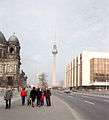 Easter Sunday 1988 Fernsehturm and Palast der Republik
Easter Sunday 1988 Fernsehturm and Palast der Republik Karl Marx Allee apartments
Karl Marx Allee apartments- Wall plaque of Lenin, off Wilhelmstraße
- GDR-era mural of Meissen porcelain on former Council of Ministers building, facing Leipziger Straße
- The Soviet War Memorial in Treptower Park
- Cafe Moskau in Karl Marx Allee
- The Palace of the Republic, being dismantled
 "Hochhaus" in Weberwiese- the first high rise apartment that was built after the war
"Hochhaus" in Weberwiese- the first high rise apartment that was built after the war- Volksbühne, Rosa-Luxemburg-Platz
 Late-1980s GDR apartment blocks on the Wilhelmstraße
Late-1980s GDR apartment blocks on the Wilhelmstraße Strausberger Platz with constructivism style building
Strausberger Platz with constructivism style building- Proletarian hero, Alexanderplatz
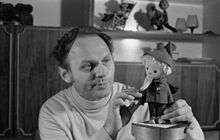 Gerhard Behrendt with Sandmännchen. The show was recorded in East Berlin.
Gerhard Behrendt with Sandmännchen. The show was recorded in East Berlin. The Bode Museum at the northern end of the Museum Island, 1956
The Bode Museum at the northern end of the Museum Island, 1956 East German guards checking cars as they exit East Berlin at Checkpoint Charlie, February, 1975
East German guards checking cars as they exit East Berlin at Checkpoint Charlie, February, 1975 Haus der Schweiz, Unter der Linden at FriedrichStrasse, East Berlin, February 1975
Haus der Schweiz, Unter der Linden at FriedrichStrasse, East Berlin, February 1975- Statues of Marx and Engels, Marx-Engels-Forum
See also
References
- Durie, W. (2012). The British Garrison Berlin 1945–1994: "No where to go". Berlin: Vergangenheits/Berlin. ISBN 978-3-86408-068-5.
- ↑ Knowles, Chris (29 January 2014). "Germany 1945-1949: a case study in post-conflict reconstruction". History & Policy. History & Policy. Retrieved 19 July 2016.
- ↑ Berlin seit dem Kriegsende, Helmut Peitsch, Manchester University Press, 1989 page 18
- ↑ Conrad Stein, R. (1997). Berlin. Children's Press. p. 29.
- ↑ Grant, R.G, (1999). The Berlin Wall. Steck-Vaughn Company.
- ↑ "Helpful Hints for US Visitors to East Berlin" (PDF). Headquarters, U.S. Command Berlin. 1981-11-09.
- ↑ Architecture, Politics, and Identity in Divided Berlin, Emily Pugh, University of Pittsburgh Press, 2014, pages 159
- ↑ Grant, R.G. (1999). The Berlin Wall. Steck-Vaughn Company.
- ↑ Conrad Stein, R. (1997). Berlin. Children's Press. p. 14.
- ↑ "Commandants of Berlin Soviet Zone". World Statesmen.org.
External links
- Berlin Photos 1989–1999
- East Berlin Past and Present
- Pictures of the GDR and East Berlin 1949–1973
- Old East Berlin Fades Away Amid Renovations
.svg.png)
.svg.png)
